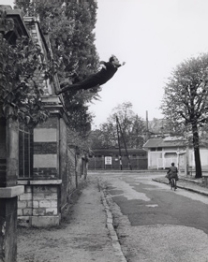Release Date: January 16, 2013
First Major Exhibition Devoted to History of Manipulated Photography through the 1980s Opens at National Gallery of Art February 17

Yves Klein, Harry Shunk, and Jean Kender
Leap into the Void, 1960
gelatin silver print
Lent by The Metropolitan Museum of Art, Purchase, The Horace W. Goldsmith Foundation Gift, through Joyce and Robert Menschel, 1992
© 2012 Artists Rights Society (ARS), New York / ADAGP, Paris; Shunk-Kender © Roy Lichtenstein Foundation; Copy photograph © The Metropolitan Museum of Art
Washington, DC—The National Gallery of Art presents the first major exhibition devoted to the art of photographic manipulation before the advent of digital imagery. Faking It: Manipulated Photography before Photoshop will be on view in the West Building's Ground Floor galleries from February 17 through May 5, 2013, following its debut at the Metropolitan Museum of Art (from October 11, 2012, through January 27, 2013). In June it travels to the Museum of Fine Arts, Houston.
"Following in its tradition of exhibiting and collecting the finest examples of photography, the Gallery is pleased to present some 200 photographs from the 1840s through the 1980s demonstrating the medium's complicated relationship to truth in representation," said Earl A. Powell III, director, National Gallery of Art. "We are grateful to the many lenders, both public and private, who have generously shared works from their collections—especially the Metropolitan Museum of Art, the largest lender and the organizer of this fascinating exhibition."
Exhibition Organization and Support
The exhibition was organized by The Metropolitan Museum of Art, New York.
This exhibition is made possible by The Exhibition Circle of the National Gallery of Art. It is also supported by the Trellis Fund. Additional support has been kindly provided by the Ryna and Melvin Cohen Family Foundation, Neil and Marcella Cohen, Diane and Howard Zack, and Mark and Theresa Cohen.
The Exhibition
This is the first major exhibition devoted to the history of manipulated photography before the digital age. While the widespread use of Adobe® Photoshop® software has brought about an increased awareness of the degree to which photographs can be doctored, photographers—including such major artists as Gustave Le Gray, Edward Steichen, Weegee, and Richard Avedon—have been fabricating, modifying, and otherwise manipulating camera images since the medium was first invented. This exhibition demonstrates that today's digitally manipulated images are part of a continuum that extends back to photography's first decades. Through visually captivating pictures created in the service of art, politics, news, entertainment, and commerce, Faking It not only traces the medium's complex and changing relationship to visual truth, but also significantly revises our understanding of photographic history.
Organized thematically, the exhibition begins with some of the earliest instances of photographic manipulation—those attempting to compensate for the new medium's technical limitations. In the 19th century, many photographers hand tinted portraits to make them appear more vivid and lifelike. Others composed large group portraits by photographing individuals separately in the studio and creating a collage by pasting them onto painted backgrounds depicting outdoor scenes. As the art and craft of photography grew increasingly sophisticated, photographers devised a staggering array of techniques with which to manipulate their images, including combination printing, photomontage, overpainting, ink and airbrush retouching, sandwiched negatives, multiple exposures, and other darkroom magic.
The exhibition presents a superb selection of manually altered photographs created under the mantle of art, including 19th-century genre scenes composed of multiple negatives, stunning pictorialist landscapes from the turn of the 19th century, and the predigital dreamscapes of surrealist photographers in the 1920s and 1930s. A section of doctored images made for political or ideological ends includes faked composite photographs of the 1871 Paris Commune massacres, anti-Nazi photomontages by John Heartfield, and falsified images from Stalin-era Soviet Russia. The show also explores popular uses of photographic manipulation such as spirit photography, tall-tale and fantasy postcards, advertising and fashion spreads, and doctored news images.
The final section features the work of contemporary artists—including Duane Michals, Jerry Uelsmann, and Yves Klein—who have reclaimed earlier techniques of image manipulation to creatively question photography's presumed objectivity. By tracing the history of photographic manipulation from the 1840s to the present, Faking It vividly demonstrates that photography is—and always has been—a medium of fabricated truths and artful lies.
Curator and Catalogue
Organized by Mia Fineman, assistant curator of photography at the Metropolitan Museum of Art, the Gallery's presentation of Faking It is curated by Diane Waggoner, associate curator of photographs, National Gallery of Art.
The exhibition is accompanied by a fully illustrated, 296-page catalogue written by Mia Fineman, published by the Metropolitan Museum of Art, and distributed by Yale University Press. The hardcover is available for purchase ($60) in the Gallery Shops. To order, please visit http://shop.nga.gov; call (800) 697-9350 or (202) 842-6002; fax (202) 789-3047; or e-mail [email protected].
General Information
Department of Communications
National Gallery of Art
2000 South Club Drive
Landover, MD 20785
phone: (202) 842-6353
e-mail: [email protected]
NEWSLETTERS:
The Gallery also offers a broad range of newsletters for various interests. Follow this link to view the complete list.